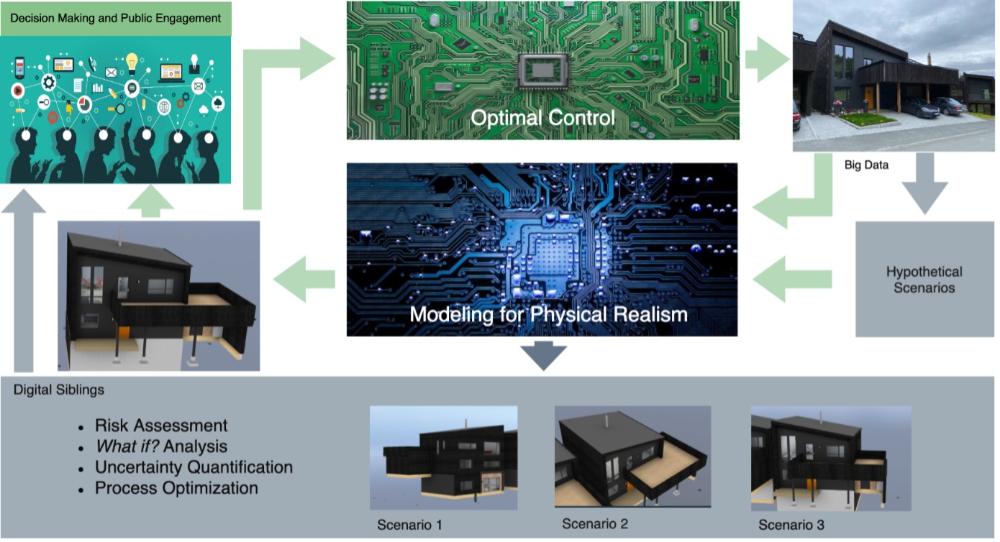TTK4853 - Virtual reality-based digital twins - Eksperter i team
Virtual reality-based digital twins
A digital twin (DT) is a virtual representation of a physical asset enabled through data and simulators for real-time prediction, optimization, monitoring, control, and improved decision-making. Based on its capability, a DT can be ranked on a scale from 0-5 (0-Standalone, 1-Descriptive, 2-Diagnostic, 3-Predictive, 4-Prescriptive, 5-Autonomous). Currently, we have buildings, greenhouse, weather, autonomous ships, drones and wind farms that can be considered good use cases.

Relevant competence
The topic of digital twin requires expertise from a wide array of subject area, so everyone is encouraged to come and contribute towards the development of this technology.
Machine Learning, Statistic, Computer Science, Human Machine Interface, IoT, Game Development, Psychology, Building Physics, Wind Energy, Agriculture, Electronics, Data Science, Cybernetics, Mathematics, Economics, Programming, Virtual Reality, High-performance computing, Optimal sensor placement
About the village
Background: The need for digitalization has achieved even higher importance during the ongoing corona pandemic. The ability to control physical assets remotely under the “work from home” situation is more relevant than ever. As the world is slowly but surely recovering from this unfortunate situation, one can expect to see a rapid expansion of technologies like digital twins. The current village aims at demonstrating how the immense potential of artificial intelligence, sensor technologies, and virtual reality, can be fused together to build highly capable digital twins.
Use cases of the digital twin: A modern smart house, a heavily instrumented greenhouse, an onshore wind farm, an offshore wind-turbine site, an autonomous ship, and drones are available as use cases. Processed data from these cases will be made available preferably in real-time. Additional data will be available through Kartverket (terrain) and the Norwegian Meteorological Institute (weather-related data). For some use cases, it will be possible to install additional sensors.
Expectations from the students: Motivation to learn, collaborate, and share. Come up with innovative cross-disciplinary solutions to solve the challenges that one faces in developing digital twins.
Examples of research questions to take as a starting point
• How to create a visually appealing and informative digital twin?
• How to address common big-data-related challenges?
• How to address common model-relate challenges?
• How to address the ethical and business-related aspects of digital twins?
Fakta
- Course code: TTK4853
- Type: Semester-based
- Language: English
- Village supervisor: Adil Rasheed
- Contact information: Adil.rasheed@ntnu.no
- Semester: Spring 2024
- Location: Trondheim
- Host faculty: IE
Viktig informasjon om EiT:
- Det unike med EiT er fokuset på samarbeidskompetanse og gruppeprosesser.
- Undervisningsformen i EiT forutsetter at alle bidrar og er til stede hele semesteret. Derfor er det obligatorisk tilstedeværelse hver landsbydag.
- I motsetning til mange emner er spesielt de første dagene viktig i EiT. Det er da dere i gruppa blir kjent med hverandre, og diskuterer hva hver enkelt kan bidra med. Dere skal også utarbeide den obligatoriske samarbeidsavtalen, samt begynne å utarbeide en felles problemstilling.
- Utfyllende informasjon om Eksperter i team finner du på siden for studenter.
